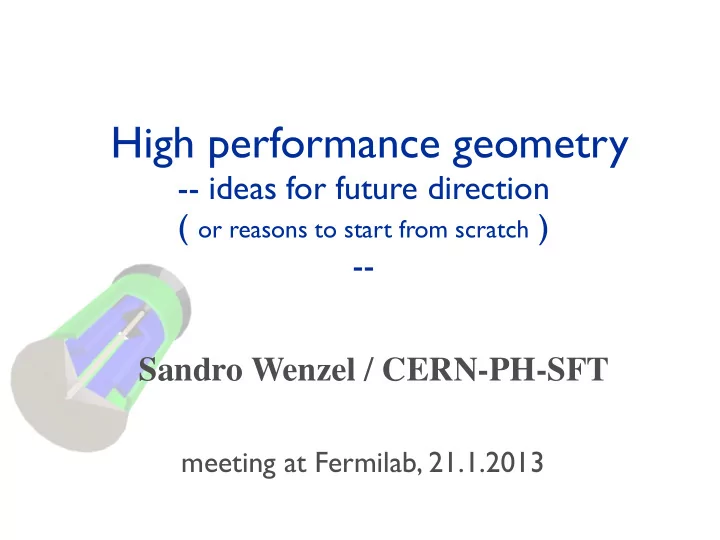

High performance geometry -- ideas for future direction ( or reasons to start from scratch ) -- Sandro Wenzel / CERN-PH-SFT meeting at Fermilab, 21.1.2013
What is current status? activity since spring 2013 focused on studying feasibility of vectorizing (primitive) geometry kernels demonstrated for a couple of shapes (box, tube, cone, tubeseg, coneseg) that this is very possible indeed with good performance gains this came at the cost of totally rewriting the routines to make them vector friendly programming model: Vc, Intel Cilk Plus ( array notation ) performance example on CPU: (simplified) navigation of particles in a logical volume with daughter shapes CHEP13: max speedup of 3.1 current status: max speedup > 4 ( with techniques discussed further down ) Sandro Wenzel
goals / challenges ahead We should now start a systematic effort to produce a “production ready” library Goals: provide a library with vectorized interfaces for important geometry kernels vectorization over particles, shapes provide a library with CUDA/OpenCL kernels for important geometry functions ( provide vectorized 1-particle functions ) achieve best performance main challenges ahead ( from my point of view ): current code does not serve for vectorization or SIMT -- there are just too many branch levels ( see for instance tube -> distanceToIn in Usolids ) hence, total code rewrite necessary ( regardless of starting point: ROOT or USOLIDS ) complete revalidation necessary Sandro Wenzel
challenges continued ... / implications targeting different backends ( vector ( Vc, CilkPlus ), GPU, scalar ) sounds like a lot of code repetition if we continue to code the way it was done in the past will be a nightmare for maintenance and testing We should hence ( these points are related ) write code which is generic kernels which work with scalar or vector arguments reuse code as much as possible without performance loss example: many kernels for tube / cone / polycone are shared and should be written only once ( without function calls ) write code which is composeable of smaller kernels Sandro Wenzel
my general proposition a templated library is a good ansatz to solve the challenges presented: you can write generic code easily with template functions you automatically write easily inlinable / reusable code since templates require coding in header files a templated library is perfect to achieve good performance: template class specialization allows to produce very optimized code for particular shapes / matrices, etc. example 1 : tube example from slides before Christmas example II : matrix transform specialization average gain ~20% compared to non-specialized code with runtime branches makes vectorization much more efficient Sandro Wenzel
Sketch of generic code idea CPU land common (static + GPU land templated) kernels (CUDA) (probably a .cu file (a .h file) (a .h file) or an .h file) inlining scalar instantiation of function inlining CUDA/scalar InZRange instanteation of function Tube::DistanceToInScalar TubeCUDAkernel_DistanceToIn InRadialRange inlining Vc instantiation of function SolveQuadraticEquation Tube::DistanceToInVector these are template functions that template on argument type, return type, tube specialisation just one generic code base ! etc. Sandro Wenzel
Very first prototype first prototype using these ideas exists currently accessible for anyone one github (VecGeom) https://github.com/sawenzel/VecGeom.git asked for repository at CERN shapes implemented: box, tube ( all variants), cones ( all variants ), polycone + some navigation methods can repeat the benchmark from CHEP13 contains branch demonstrating generic generation of CUDA, Vc and scalar functions out of same template functions our technical student (Johannes) successfully ran first tests on CUDA and CPU should sit down in a working group to look at this code ... Sandro Wenzel
My expectations for this week hearing CUDA ideas and your requirements do you need a kernel for every shape primitive or for just for some scope of kernels virtual function problem study of the prototype and decision of how to proceed setup of a common workplan and milestones coding conventions setup of a plan to integrate this work ( step by step ) setup of a plan to test this work Sandro Wenzel
compatibility etc. USolids was started as a unified solid library .... ideally the vectorized work should become parts of USolids however coding ansatz completely orthogonal to USolids at the moment VecGeom could become USolids2.0 / UGeom ??? We should definitely use the interfaces of USolids to start with Sandro Wenzel
Recommend
More recommend